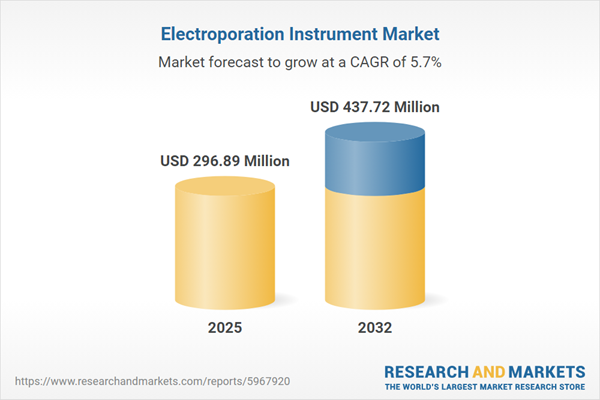Speak directly to the analyst to clarify any post sales queries you may have.
The electroporation instrument market is evolving rapidly, spurred by technological advancements and expanding research applications. Senior executives and procurement leaders require reliable, actionable insights to guide strategic investments, drive efficiency, and optimize their competitive positioning within this dynamic sector.
Market Snapshot: Growth of the Electroporation Instrument Market
The electroporation instrument market grew from USD 281 million in 2024 to USD 296.89 million in 2025. It is projected to maintain robust momentum at a CAGR of 5.69%, reaching USD 437.72 million by 2032. This trajectory reflects accelerating adoption in life sciences, clinical research, and commercial manufacturing as advanced cellular engineering strategies proliferate globally.
Scope & Segmentation of the Electroporation Instrument Market
Market analysis encompasses a comprehensive segmentation to give stakeholders a clear picture of demand drivers and opportunities across the following:
- Product Types: Accessories and Consumables (cuvettes, electrodes, flow cells), Instruments (bench-top systems—multi pulse and single pulse, handheld devices)
- Application Areas: Academic research (cancer, molecular biology, vaccine development), Contract research organizations (clinical and preclinical research), Pharmaceutical & biotechnology (agricultural biotechnology, cell therapy, gene therapy)
- End User Segments: Academic & research institutions, Contract research organizations, Hospitals & clinics, Pharmaceutical & biotechnology companies
- Technology Types: Batch processing, Continuous flow systems
- Cell Types: Adherent cells (insect, mammalian, plant), Suspension cells (bacterial, mammalian suspension, yeast)
- Geographic Regions: Americas (North America—United States, Canada, Mexico; Latin America—Brazil, Argentina, Chile, Colombia, Peru), Europe Middle East & Africa (Europe, Middle East, Africa), Asia-Pacific (China, India, Japan, Australia, South Korea, Indonesia, Thailand, Malaysia, Singapore, Taiwan)
- Leading Companies: Thermo Fisher Scientific Inc., Lonza Group AG, Bio-Rad Laboratories, Inc., Merck KGaA, Eppendorf AG, Harvard Bioscience, Inc., MaxCyte, Inc., BEX Co., Ltd., Nepa Gene Co., Ltd., CytoPulse Sciences, Inc.
Key Takeaways for Senior Decision-Makers
- Adoption of electroporation instruments is rising as organizations prioritize genomic editing, cell therapy, and synthetic biology.
- Working with advanced electroporation platforms enables streamlined workflows, scalability, and robust data analytics to drive reproducibility in critical research settings.
- Segmented solutions—spanning modular hardware and software integrations—deliver operational flexibility to accommodate diverse cell types and experimental requirements.
- Strategic alliances with research centers and consumables providers foster product optimization and ensure business resilience amid evolving needs.
- Continuous innovations, including microfluidic platforms and machine learning–enhanced control software, are accelerating the transition toward high-throughput applications and precision outcomes.
Impacts of U.S. Tariffs on Market Supply Chains
Forthcoming tariffs in the United States will affect both components and finished electroporation instruments, prompting stakeholders to adapt procurement strategies and consider nearshoring or domestic production to sustain competitive pricing. This policy change may lead end users to explore alternative sourcing and flexible acquisition models such as leasing or shared instrumentation, while supply chain partners invest in proactive forecasting and inventory management to buffer against volatility.
Primary Keyword: Electroporation Instrument Market Methodology & Data Sources
This report employs both quantitative and qualitative methodologies, integrating executive interviews, expert surveys, and systematic reviews of scientific, regulatory, and company literature. Segmental frameworks and regional insights are validated using multi-source triangulation to ensure accuracy and actionable conclusions.
Why This Report Matters
- Delivers actionable intelligence for investment prioritization, R&D alignment, and supply chain risk management.
- Offers clarity on emerging trends, partnership avenues, and evolving compliance requirements for decision-makers seeking strategic growth.
Conclusion
The electroporation instrument market is poised for significant advancement, shaped by technology integration, collaborative innovation, and adaptive supply chain strategies. Leaders leveraging these insights can confidently drive organizational resilience and long-term value creation in this fast-moving landscape.
Additional Product Information:
- Purchase of this report includes 1 year online access with quarterly updates.
- This report can be updated on request. Please contact our Customer Experience team using the Ask a Question widget on our website.
Table of Contents
3. Executive Summary
4. Market Overview
7. Cumulative Impact of Artificial Intelligence 2025
Companies Mentioned
The companies profiled in this Electroporation Instrument market report include:- Thermo Fisher Scientific Inc.
- Lonza Group AG
- Bio-Rad Laboratories, Inc.
- Merck KGaA
- Eppendorf AG
- Harvard Bioscience, Inc.
- MaxCyte, Inc.
- BEX Co., Ltd.
- Nepa Gene Co., Ltd.
- CytoPulse Sciences, Inc.
Table Information
| Report Attribute | Details |
|---|---|
| No. of Pages | 190 |
| Published | October 2025 |
| Forecast Period | 2025 - 2032 |
| Estimated Market Value ( USD | $ 296.89 Million |
| Forecasted Market Value ( USD | $ 437.72 Million |
| Compound Annual Growth Rate | 5.6% |
| Regions Covered | Global |
| No. of Companies Mentioned | 11 |









